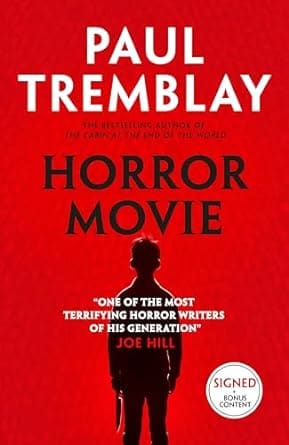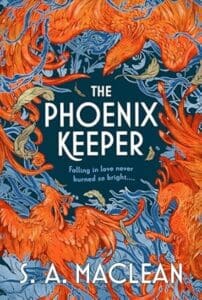
Synopsis:
Summer, 1993 – a group of young guerrilla filmmakers spend four weeks making Horror Movie, a notorious, disturbing, art-house horror film. Steeped in mystery and tragedy, the film has taken on a mythic, cult renown, despite only three of the original scenes ever being released to the public.
Decades later, a big budget reboot is in the works, and Hollywood turns to the only surviving cast member – the man who played ‘the Thin Kid’, the masked teen at the centre of it all. He remembers all too well the secrets buried within the original screenplay, the bizarre events of the filming, and the crossed lines on set.
Caught in a nightmare of masks and appearances, facile Hollywood personalities and the strangeness of fan conventions, the Thin Kid spins a tale of past and present, scripts and reality, and what the camera lets us see. But at what cost do we revisit our demons?
After all these years, the monster the world never saw will finally be heard.
Review:
“Horror Movie,” by Paul Tremblay is a maelstrom of sorrow, confusion and unrelenting fright. When a copy of it miraculously appeared on my doorstep, two things immediately became apparent: first, despite my current unemployment and aversion to any and all social interactions, I have in fact made it in life, and second, that this book would deliver on the sheer terror it promises. From the obvious implication of it being a Paul Tremb(le in fear)lay novel, to the sinister cover art, this is a book that guarantees screams and sweat patches from beginning to end. I took copious notes. I have ramblings, theories and conspiracies I desperately need to get out of my system (I’m genuinely one step away from pulling out a cork board and some red string) so I’m for-going my usual elaborate preamble: this is a book that can and should speak for itself. (I say that, but will continue to type until my fingers hurt).
At its most basic, “Horror Movie,” is a story on top of a story, sandwiched between not one, but two slasher flicks. The common thread amongst each component is our enigmatic narrator. In 1993, he was approached by Cleo and Valentina, two aspiring Hollywood stars, with a “proposal.” They present him with a screen-play: “Horror Movie,” and practically beg him to star as the silent, masked, yet pivotal character of “Thin Kid.” We get to read the screen-play in question at the end of each chapter, which follows Cleo, Valentina and Karson (as themselves) and their horrific abuse of our narrator’s character.
Unfortunately, the filming process did not go as planned, and today, only 3 short snippets of the film, and a few stills are available on the internet. The internet however, is a strange place, and it’s not long after these are posted that the film gains a following, a fandom, a cult. As the only surviving main cast member of a film shrouded in such mystique, today, the protagonist is regularly hounded by producers and directors wanting to reboot “Horror Movie,” and confident he’s finally found the woman to pull it off, the time for a revival may finally be upon us.
Tremblay deftly explores cinematic horror, artistic expression, and as hinted above, the phenomenon of cult fandom- something I’m sure he experienced following the hit that was “Knock at The Cabin,” last year. One thing we learn from this novel is that it is incredibly easy to lose control of something we create. This is apparent through the vital and viral resurgence of the fragmented “Horror Movie”, which allows for reflection upon the often obsessive nature of fandom, perhaps insinuating that some works can attain a life of their own, driven by the fervent devotion of their audience. This allows Tremblay the opportunity to pay homage to horror as a genre, whilst also delightfully, casually slandering Hollywood culture. He touches on the power that film can hold, whilst also highlighting the interplay between reality and artifice, and that art can both reflect and distort what we know to be real.
“Thin Kid,” is a character study that I could drag out for pages upon pages (don’t worry, I’ll spare you). We read from his first person perspective, both “Then,” and “Now,” and he often breaks the fourth wall, adding “meta,” to this novel’s ever-growing list of impressive features. His narration is sardonic, dry, and he appears to be relatable. He’s a character that we certainly don’t dislike- yet will never be able to trust completely. His persistent self-identification as the “Thin Kid,” suggests a deep sense of alienation, an outcast status and a tonne of personal damage both on and off screen, and whilst he consistently elicits our sympathy (perhaps even empathy depending on your own adolescence) again, we are wary of his reliability.
I am now going to say something that I certainly do not take lightly. Brace yourself. “Horror Movie,” is a reading experience that, at least for me, channels elements of King’s “Carrie.” For those unacquainted with this literary right of passage (blasphemy) then you can read Anna’s full run-down here.
Tremblay has no qualms in telling us that by the time we are reading this novel, most of the characters are dead. King employs an epistolary format (something Tremblay executes with the same finesse) which also explicitly tells the reader that the majority of the characters we’re reading about have already met an untimely demise. King and Tremblay both rather quickly reveal the story’s trajectory, and as readers, we burn through the book, desperate to fill in the gaps.
We should next consider Cleo’s (on-screen) character. She partakes in the bullying of the “Thin Kid,” and externally laughs and jokes amongst her friends. She stubs out cigarettes on him, and later returns to help ensure the wound does not get infected: this very same duality is most famously present in King’s Sue Snell. It explores the internal struggle, I’m sure we all suffered as teenagers, between peer pressure and our own morality.
It’s main and most compelling argument however lies in the idea that monsters are not born, they are made. Whilst, yes, Tremblay chronicles the literal creation of a monster (that’s Hollywood baby!) he also explores this concept metaphorically. In a manner reminiscent of Carrie, who is pushed to her limits by her cruel classmates, before inevitably snapping in a cataclysmic display of violence- Horror Movie gradually unmakes its characters’ humanity. Tremblay demonstrates that there is a latent darkness within all of us – and this is where horror truly lies. These shared themes of transformation and the creation of evil shows that monsters can in fact be human, and that they are made not born. All things considered, whether intentional or not, I really believe that if the likes of Catriona Ward wrote “Carrie 2: Carrie Goes To Hollywood,” then you may well end up with something a little like this.
Before I finally bid you farewell, there are two scenes we need to discuss, admittedly in a convoluted, spoiler-free way. Let’s go chronologically.
Toward the end of the novel, the screen-play takes a very interesting turn. Our destination? One of the most chilling, utterly terrifying, yet self-reflective and poignant few pages in horror… ever. Ed, in his stellar, Paul-approved review, likens it to that scene in “It Follows,” a comparison that hits the nail on the head so perfectly, I am forced to blatantly plagiarise it (sorry pal). With, yeah, impending doom simmering away in the background, Tremblay stops for a moment. He tells us about the importance of horror, forces us to think about our own relationship with it, and he does so by capturing that fleeting moment of pure, unadulterated fear before a jump-scare, and drags it out, forcing us to confront it head on. Is the “Thin Kid,” the unreliable narrator? Is he manipulating the truth? Or has it been you, the horror fanatic all along?
Finally, the ending. “Chapter 20: Now.” It’s as shocking as the last few pages of Ward’s “The Last House on Needless Street,” it’s as existential as the twist in Reid’s “I’m Thinking Of Ending Things,” and I’m confident that it will be as well-received as the fever-dreamish denouement in Banks’ “The Wasp Factory.” What I’m trying to say, is that it’s really, fucking good, in a staring at the wall for the foreseeable future, rocking yourself to sleep kind of way.
It’s going to be hard to summarise, considering I’ve rambled for twice the time I usually do, but I shall try nonetheless. Horror Movie is a brilliant, thought-provoking read that masterfully explores horror as a genre, but also as a deeply personal experience. Complex and resonant, it is sure to scare the bejesus out of horror connoisseurs and casual-readers alike. It releases from Titan books on June 11th.









Leave a Reply